Catalina 470 Review – Boatpoint Website (August 2000)
Words – David Lockwood
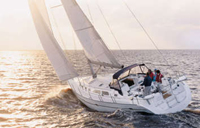 The Catalina 470 is in the cruising big league. And David Lockwood discovers, with its latest model the American production yacht giant is not just ‘talking big’
The Catalina 470 is in the cruising big league. And David Lockwood discovers, with its latest model the American production yacht giant is not just ‘talking big’
Winter sailing was never meant to be this good. Clear skies and an unseasonably warm 10kt northerly painted Pittwater in a perfect light. The temperature, a snow-melting 19°C, brought shrills of delight from the local fairy penguins, whose calls echoed the pleasure being had aboard Catalina’s 47ft flagship passagemaker.
According to the brochure from the American production yacht giant, the 470 offers a level of performance, comfort and safety that effectively raises the bar for the entire cruising category. According to those onboard, the big 47-footer knows no bounds.
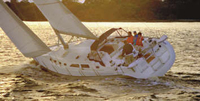 Our sail on Pittwater was like a stroll in the park compared with the yacht’s past and present tenure. Having been shipped to Sydney, the 470 was sailed north for the Sanctuary Cove Boat Show, then delivered back to Sydney before readying itself for a voyage south.
Our sail on Pittwater was like a stroll in the park compared with the yacht’s past and present tenure. Having been shipped to Sydney, the 470 was sailed north for the Sanctuary Cove Boat Show, then delivered back to Sydney before readying itself for a voyage south.
Along the way, those aboard the big yacht encountered the spectrum of winter weather. Though they missed out on the perfect winter conditions which marked the test sail, the crew spoke of everything from motoring for lack of breeze to beating home into a brisk 37kt sou’westerly. That is, from 40nm east of Port Stephens.
The point Catalina importer Norm Ambrose makes is that people do sail long distances in Catalinas. One fleet-footed owner of a 42-footer packed his bags and sailed from Adelaide to Turkey. Two other owners of 42s that Ambrose knows have cruised around the South Pacific. I wonder what they would give for the big 470?
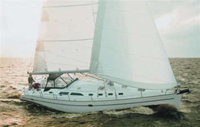 Catalina’s purpose-built passagemaker offers more space, security and, as the brochure says, comfort, than any other yacht in the range. And bigger is most definitely better when it comes to passagemakers.
Catalina’s purpose-built passagemaker offers more space, security and, as the brochure says, comfort, than any other yacht in the range. And bigger is most definitely better when it comes to passagemakers.
CATERING FOR CRUISING
Like a well-built house, a good cruising yacht must succeed on several levels. These include having the ability and stability to weather a big blow, being slippery enough to make headway in a fickle wind, and having the all-important home-away-from-home accommodation.
Along the way, things such as engineering, serviceability, and user-friendliness each play a role.
To this end, my short but sweet sail along Pittwater only offered a few clues about the 470’s offshore sailing potential. But potential it most certainly has.
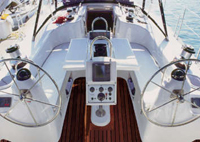 Available in either two or three-cabin versions, the yacht is at once an ideal mobile home for an adventurous couple and a commodious cruiser for a big crew wanting to contest the ocean races north to the Whitsundays each winter. Further, the three-cabin 470 I tested was fitted with an optional tall rig, providing 8.1% more sail area than the standard rig.
Available in either two or three-cabin versions, the yacht is at once an ideal mobile home for an adventurous couple and a commodious cruiser for a big crew wanting to contest the ocean races north to the Whitsundays each winter. Further, the three-cabin 470 I tested was fitted with an optional tall rig, providing 8.1% more sail area than the standard rig.
With a bigger main and genoa, the 470 felt decidedly powerful in the light airs. The yacht’s part-owner, Richard Hamilton from Ausail at Pittwater, went for the taller rig for additional performance during around-the-cans club racing.
The bigger rig will also help make the boat more attractive to corporate sailors. After all, the last thing a successful businessman wants is to be last over the line.
“The 470 is lively by Catalina’s standards,” says Hamilton.
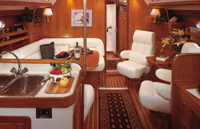 In just 10kt of breeze with the full main and number two furling headsail, I cracked six knots upwind. While the fixed prop seemed to create some drag, the hull nevertheless felt slippery. To counter the power, Hamilton had an additional reefing point added to the main. The reefing line leads back to the cockpit.
In just 10kt of breeze with the full main and number two furling headsail, I cracked six knots upwind. While the fixed prop seemed to create some drag, the hull nevertheless felt slippery. To counter the power, Hamilton had an additional reefing point added to the main. The reefing line leads back to the cockpit.
Ballasting comes in two forms, but with lead keels. There’s a 1.68m shoal-draft winged keel swinging 4332kg of lead or, on the test yacht, a 2.39m deep-fin keel with 3992kg of lead. The displacement of the 470 is 11,794kg, with an additional 340kg in the shoal-draft version. For stability, the deep-keel makes more sense, of course.
TWO CREW IS ENOUGH
As for user-friendliness, two people can easily sail the Catalina 470.
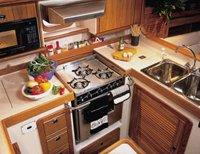 All lines lead back along the cabin top through Lewmar clutches to the cockpit. There is an electric winch for the main halyard, and a Dutchman reefing system that self-flakes the full-battened main. Options include in-boom or mast furling and electric genoa winches.
All lines lead back along the cabin top through Lewmar clutches to the cockpit. There is an electric winch for the main halyard, and a Dutchman reefing system that self-flakes the full-battened main. Options include in-boom or mast furling and electric genoa winches.
The traveller, which is on the cabin top and thereby frees up the cockpit, has a unique fore and aft rotating system to lessen the load on the mainsheet. The sheets for the roller-furling genoa, meanwhile, lead back to raised tracks and custom cheek blocks to perfectly apt, oversized Harken 66 two-speed winches.
The double-spreader masthead rig, while deck stepped, appears well-stayed.
Offsetting the enormous aft beam are twin wheels that offer a clear view down both sides of the headsail. Crew members, meanwhile, have pushpit seats positioned some two metres apart and plenty of bumrests in the wide cockpit.
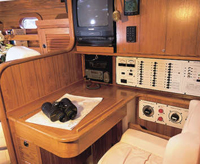 The outdoor living areas cater to lifestyle pursuits. Access is unobstructed to the big boarding platform, deck shower, and the multipurpose pedestal in the centre of the cockpit. The pedestal harbours a flip-top dash for electronics, including GPS plotter and windlass, plus lunch table and central icebox with drink holders.
The outdoor living areas cater to lifestyle pursuits. Access is unobstructed to the big boarding platform, deck shower, and the multipurpose pedestal in the centre of the cockpit. The pedestal harbours a flip-top dash for electronics, including GPS plotter and windlass, plus lunch table and central icebox with drink holders.
Because the twin or massive single aft cabins (depending on which version of the 470 you buy) take up most of the yacht’s aft space, the cockpit storage lockers are on the small side. Though the twin aft lockers access a lazarette and the steering gear, their narrow entry will make retrieving a rubber ducky and outboard a challenge. But perhaps the high-cut headsail and big foredeck will allow you to keep your ducky on deck.
The amount of deck space on the 470 makes moving from bow to stern, or for racing crew crossing over the cabin top, a breeze. Other deck features include handrails and, though an after-market inclusion, that most essential of cruising equipment – the rail-mounted barbie!
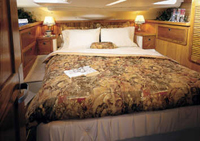 Though the 470 can sleep nine people, its cockpit is so big you could easily sleep another two or three outdoors. Fitted with clip-in cushions, you can find comfort behind the big dodger. I could easily imagine reclining out here with a half-empty bottle of red, looking up at star-filled tropical skies in the Whitsundays – much like one would on a big cruising cat.
Though the 470 can sleep nine people, its cockpit is so big you could easily sleep another two or three outdoors. Fitted with clip-in cushions, you can find comfort behind the big dodger. I could easily imagine reclining out here with a half-empty bottle of red, looking up at star-filled tropical skies in the Whitsundays – much like one would on a big cruising cat.
INTERIOR BEAUTY
Having said that, the 470’s interior is a beauty. As far as homes-away-from-home go, the yacht is more a castle than a cottage.
Headroom is way up there – perhaps as high as 2.2m. Thus the general feeling is one of airiness and open-plan living, though the overhead lockers over the galley return cut the view when you first step inside.
By my observations the joinery has improved compared with some ‘pop-out’ Catalinas I’ve been on. The jigsawing, gumming-up with Sikaflex, and self-tapered veneer panels were less conspicuous – which is just as well on a $500,000 luxury yacht. Satin-varnished teak and some holly between floor planks were used to good effect. A white headliner and plenty of hatches catch the natural light, while 12V lighting extends to the lockers in the cabins.
While practical at anchor only, the forward head includes a washer-dryer in the shower recess. The amidships day head, on the starboard side near the companionway, also includes a full-sized shower stall and the only electric loo on the boat. The third head serving the portside cabin is smaller, with a hand-held shower tap.
Servicing these and the cockpit shower is a 75lt hot-water service with heat exchanger and separate element. Fuel for the fresh-water-cooled 75hp Yanmar is 318lt split between two tanks, with selection valves and separate filters. All the tanks are monitored by a Norwegian Wema analogue gauge at a doubly impressive circuit-breaker board alongside the navigation station.
The nav station to starboard, in the conventional spot opposite the galley, points to the 470’s cruising intent.
As part of the package, you get Autohelm ST80 instruments with some repeaters, Raytheon VHF, a full circuit-breaker board with two house batteries, one engine-start battery, built-in battery charger, and intricate bilge system.
Nearby, is an entertainment system facing the main U-shaped lounge and dinette on the portside, ahead of the galley. Built into the teak cabinetry are colour television and VCR operating off a 12V inverter, Sony sound system and 10-stacker CD, and internal Bose speakers, as well as waterproof speakers outdoors.
Opposite the main dinette is a nifty lounge that converts into a second, more intimate dinner setting for two.
At a recent Catalina raft-up, 13 people apparently dined below on the 470. (The meal they enjoyed was a roast dinner with gravy and vegies.) Though a few people had to sit on the companionway steps, you can appreciate just how big the 470 is inside. The lounges also double as sea berths.
The galley includes a DC-powered compressor for two separate fridge/freezer systems, with pumps for discharging the thaw-water.
There’s a built-in microwave, three-burner LPG stove (bottles in transom) with oven, in-counter receptacle, and lots of drawers and overhead cabinets for crockery, cutlery, spices and cruising provisions.
Well-heeled couples will find the two-cabin 470 offers a level of accommodation to rival a centre-cockpit yacht. The three-cabin model, with twin aft staterooms with hanging lockers and heads, appeared indulgent enough.
Though listed as a guest’s cabin, the up front could be used as a stateroom at quiet anchorages. The brochure points to a large pullman berth being built-in. Confining the crew to the bow so you can retain some privacy back aft, especially in the two-cabin boat, is very European.
Buyers will need to supply their own manchester, cushions. etc for all cabins.
SAILING AWAY
The tour of the 470’s interior took almost as long as my tour of Pittwater. In a sense, both were adventures. It’s just a shame that on this perfect winter’s day we couldn’t poke our nose out through Broken Bay and reach up the coast. The boat’s solid-glass construction and structural fibreglass grid system are designed for such things.
The way the importers put it, the Catalina 470 is an owner-driven design for long-term living. Hence the 810lt of water and 335lt of fuel, the collision bulkhead, and the big stainless stemhead. Hence the reason the owner has sailed the yacht up and down the eastern seaboard chasing the boat shows.
The vice-president of Catalina in America, Perry Douglas, met local agent Norm Ambrose on a recent tour and said his 470 was for experienced sailors who want to do some serious cruising. “Most will have come up through the 38s and 42s,” he said, “and for them the 470 will be a natural progression.”
But to make life even more comfortable, the owners fitted a full spread of instruments including radar, airconditioning, leather upholstery, and, as I discovered, a good stock of Tim Tams.
The only thing missing was a bit more time to enjoy the sailing.
HIGHS
A passagemaker with almost as much space as a cruising catamaran; user-friendly handling with surprisingly lively performance thanks to an optional tall rig.
An owner’s boat, the 470’s interior is the best yet from America’s most frenetic production-yacht builder.
LOWS
The fixed prop creates drag, the stainless work needed polishing, serious cruising folk might prefer a keel-stepped mast.
Despite three heads, there is just one electric loo.
Cockpit storage was tight for a ducky.
The return over the galley hindered with the open-plan layout.
CATALINA 470
Price as tested $640,000*
OPTIONS FITTED
Genset, instruments and radar, airconditioning, leather upholstery, bedding, taller rig, and more.
PRICED FROM $ (two cabin), $ (three-cabin version)
GENERAL
Material: Fibreglass
Type: Monohull
Length (overall/waterline): 14.17m/12.80m
Beam: 4.27m
Draft (std/shoal): 2.39m (fin keel)/1.68m (wing keel)
Displacement: 11,794kg (fin keel)/12,133kg (wing keel)
Ballast (std keel): 3992kg (fin keel)/4332kg (wing keel)
CAPACITIES
Berths: 7-9 (two or three-cabin)
Fuel capacity: 335lt
Water capacity: 810lt (75lt hot water)
ENGINE
Make/model: Yanmar
Type: Four-cylinder
Rated hp: 75hp
SAIL AREA
Furling main: 17.75sqm/19.10sqm (tall rig)
Battened: not given
Genoa: 15.70sqm/17.04sqm (tall rig)
* Prices & data correct at time of publication
